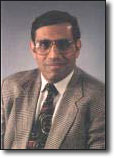
2005 IEEE International Conference on Acoustics, Speech, and Signal Processing
March 18-23, 2005 • Pennsylvania Convention Center/Marriott Hotel • Philadelphia, PA, USA
ICASSP
30th Anniversary
Tutorial TUT-12: Signal processing for sensor networks
Instructors
R. Rao; Rochester Institute of Technology
P. Varshney; Syracuse University
Time & Location
Saturday, March 19, 13:30 - 16:30, Location: CC: Room 113-A
Abstract
Intended audience: Engineers and scientists from academia and industrial organizations in the fields of signal processing and communications wishing to acquire an overview of sensor networks and associated signal processing issues.
Objectives: At the conclusion of the tutorial, the audience should:
- Be able to enumerate key attributes of sensor networks and identify differences between sensor networks and ordinary communication/computing networks.
- Be able to explain the role of signal processing in front-end information extraction and the reduction of transmitted data.
- Have developed, at a minimum, a technical layperson’s understanding of collaborative signal processing and energy aware sensor network operation.
- Be able to identify several defense and commercial applications of sensor networks.
Summary: There has been an explosive growth in the amount of effort devoted to the field of senor networks in recent years covering a wide range of areas, from sensor fabrication to protocol development to understanding theoretical issues. The surge in interest is due substantially to the fact that technological development in sensors and communication has made the practical realization of such networks possible. Ultra small sensing devices based on micro-electromechanical or MEMS processes, wireless multi-access technology and GPS-based geolocation are some examples of technologies that have fueled the current interest in the field. Today, more than ever, sensor networks offer exciting applications in a wide range of fields such as defense, medicine, law enforcement, and space exploration. Research and development in sensor networks cover many different aspects of which signal processing is an important component.
This tutorial will provide an overview of the field of sensor networks and detail the part played by signal processing in their design and operation. Sensor networks typically consist of miniature battery-operated sensor nodes with wireless communication capabilities deployed in an ad hoc manner. One of the requirements in such deployments is that the amount of data transmitted be limited both to conserve the typically low energy pool of the autonomous sensors and to conserve bandwidth. Signal processing plays an important part in this process through application of techniques such as data aggregation, compression, sensor fusion and target/event detection. Such methods allow a certain amount of front-end processing that reduces the amount of transmitted data, thus limiting channel usage, while ensuring that application requirements are still met. The role of signal processing in sensor networks is also critical in other areas of sensor network implementation such as energy-aware routing, collaborative signal processing, and clustering. Indeed, the different aspects of sensor network operation should be integrated, making signal processing an essential part of the design of sensor networks.
Topics:
- Sensor network description and basic definitions.
- Example applications.
- Energy and bandwidth constraints.
- Sensor coverage and redundancy.
- Data aggregation: correlation strategies, compression.
- Tradeoffs between local processing and communication.
- Maximizing sensor and network lifetime. Clustering strategies and protocols.
- Implementation approaches:
- Mobile agents.
- Optimization through evolutionary programming approaches
- Emergent behaviors
- Collaborative signal and information processing
- Distributed coding and compression.
- Data and sensor fusion.
- Target/event detection.
- Applications
Materials provided: Tutorial slides and extensive references to relevant literature.
Presenter Information

Raghuveer M. Rao received the B.E. degree in Electronics and Communication Engineering from Mysore University, the M.E. degree in Electrical Communication Engineering from the Indian Institute of Science and the Ph.D. degree in Electrical Engineering from the University of Connecticut. He has been with the Rochester Institute of Technology, Rochester, NY since December 1987 where he is a Professor of Electrical Engineering and a member of the Ph.D. faculty of the Center for Imaging Science. His current research efforts are in the areas of image modeling, network traffic modeling and sensor networks. His research group has been successful in developing particle swarm based optimization approaches for sensor network clustering and coverage problems. Prof. Rao is a past Associate Editor of the IEEE Transactions on Signal Processing and the IEEE Transactions on Circuits and Systems II. He is currently an Associate Editor of the Journal of Electronic Imaging. He is a recipient of the IEEE Signal Processing Society’s Best Young Author Paper Award and a Fellow of SPIE --- the International Society for Optical Engineering.

Pramod K. Varshney received the B.S. degree in electrical engineering and computer science (with highest honors), and the M.S. and Ph.D. degrees in electrical engineering from the University of Illinois at Urbana-Champaign in 1972, 1974, and 1976 respectively. Since 1976 he has been with Syracuse University, Syracuse, NY where he is currently a Professor of Electrical Engineering and Computer Science and the Research Director of the New York State Center for Advanced Technology in Computer Applications and Software Engineering. His current research interests are in distributed sensor networks and data fusion, detection and estimation theory, wireless communications, image processing, radar signal processing and parallel algorithms. He is a member of Tau Beta Pi and is the recipient of the 1981 ASEE Dow Outstanding Young Faculty Award. He was elected to the grade of Fellow of the IEEE in 1997 for his contributions in the area of distributed detection and data fusion. He was the guest editor of the special issue on data fusion of the Proceedings of the IEEE, January 1997. In 2000, he received the Third Millennium Medal from the IEEE and Chancellor’s Citation for exceptional academic achievement at Syracuse University. He serves as a distinguished lecturer for the AES society of the IEEE. He is on the editorial board of Information Fusion. He was the President of International Society of Information Fusion during 2001.